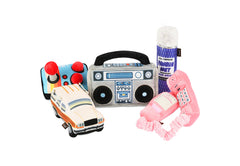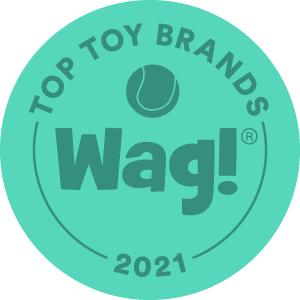You’ve come home with your wiggly, energetic new pup. You love their enthusiasm, but they’re bouncing off the walls, chewing your shoes and peeing on the rug. Now what?
House Training
The biggest training hurdle for most new pup parents is house training. No one wants to continually clean up puppy mess, so it’s best to start early and work often with your pup to get her housebroken. If you follow this ultimate guide to house training a puppy, we know you’ll be prepared for whatever comes your way!
Experts say that you should begin to house training your pup between 12 and 16 weeks of age. Puppies younger than that don’t have the capacity to hold their bladders for any length of time, and so housetraining for those pups 12 weeks and under won’t be terribly effective.
Puppy pads are recommended for younger dogs until they are ready to begin house training. If you’re more busy and have to be out of the home for many hours a day, there are some options for you as well! The most notable would be the Puppy Potty Pad Method, or the Paper-Training Method. It is great for several different scenarios: If you don’t have the schedule where you can take your dog out every 30 minutes or every hour for the first several months, then you will need something indoors which is acceptable.
However, if your puppy is older than 12 to 16 weeks and has not started potty training, the process may be slightly more difficult, as you may have to help them unlearn problem behaviors like peeing on rugs or ingesting their own waste.
Give Puppy Some Space
To start, you should confine your puppy within a small area to reduce the risk of accidents. Puppies left with a large area to roam, such as a whole house, may be tempted to potty in a secluded area instead of outside. To avoid unnoticed accidents, provide your puppy with a crate or a small room as you begin to potty train. That way, your sweet new fuzzball feels uncomfortable using the bathroom in the same space where it plays, sleeps and eats.
Set a Mealtime
From there, it is important to keep your puppy on a regular feeding schedule. Try to feed your pup at approximately the same time and take up food when it's not mealtime. By controlling access to food, your pup won't be able to snack throughout the day, so timing potty trips should be easier.
Take Frequent Bathroom Trips
Because puppies have notoriously small bladders, it's imperative that bathroom breaks are often taken. Ideally, you should take your pup out first thing in the morning and continue to take him out every 30 minutes to an hour for the rest of the day. Your pup should also make bathroom trips, regardless of the time, directly after every meal. Potty trips after nap time, right before bed, or before he’s left alone for any length of time are also recommended. As your puppy becomes more proficient at pottying, he may go longer intervals without using the bathroom and may even let you know when he needs to go. Whining, barking, sniffing, and scratching at the door may all be signs that your pup needs to go.
Pick a Spot
To help your pup remember to go outside, rather than in the house, it's helpful to take her to the same general area every time she needs to potty. The scent of previous bathroom trips will help her remember what she's there to do.
Be a Good Chaperone
The outside can be a big wondrous place for a small puppy, so it may be tempting for your furry friend to explore rather than going potty. To keep your pup on track and avoid wandering, be sure to accompany your new dog on each bathroom trip until you're confident he has mastered house training. It may be easier to stay inside, but you won't know if your pup has done his business if you aren't there to supervise.
Reward Right Behavior
The fastest way to get the house training results you want is to reward your pup’s correct potty practices. Whenever she uses the bathroom outside, praise her for a job well done. The reinforces positive behaviors and shows her how proud you are of her progress. Rewards could be treats, playtime with a favorite toy,
Crate Training
An excellent compliment to house training, crate training can give your pup a confined space that will promote faster housetraining and a designated area for your pup to call her own. Because dogs don’t like to potty where they sleep, she should avoid using the bathroom in her crate unless she can’t hold it any longer. Additionally, the crate should offer your pup a soft, cozy place for her to rest when you can’t monitor her behavior. Because puppies have razor sharp teeth and boundless energy, they tend to be relatively destructive when first brought home. To help curb this destructive behavior, teach your pup to behave while utilizing a crate with these few simple steps.
Choose a Crate
To start, select a crate. Crates come in a variety of sizes and styles, including wire, plastic, and mesh. Deciding which one is right for your pup will depend on his size and temperament and your individual preferences, but a good rule of thumb is that a crate should be big enough for your pup to stand up without crouching, turn in a circle, and lie down comfortably. Any bigger and your pup may use one end of his crate as a toilet; any smaller and she will be too uncomfortable to get any rest.
Cozy it Up
To create a comfortable, welcoming environment, be sure to outfit your puppy's crate with a soft bed or blanket and a few toys. Make sure to place the crate in a room where you spend lots of time, so your pup doesn’t feel isolated or forgotten. To ensure that your dog associates their crate with good things, you may want to place treats and/or your pup’s food in the crate and leave the door open, allowing them to explore at their leisure.
Warm Them Up
After creating a cozy crate, it’s time to introduce your pup to their new space. Start by telling her to “Go to bed” or whatever command you’ll use to ask her to go into the crate. From there, throw a treat into the crate. When your pup follows the treat, praise her enthusiastically and offer her another treat while still inside the crate. Then tell her “Okay” and allow her to leave the crate. Repeat over multiple training sessions until your pup is comfortable. Next, begin to point to the crate when issuing the command, rather than throwing the treat. Once your pup enters the crate, reward her with a treat and praise her. Repeat until your pup readily follows your command.
Close the Door
Following the procedure outlined above, begin closing the crate door when your pup enters his crate. Offer your dog a few treats through the closed door before letting him out. Repeat until your pup is comfortable with the closed crate door.
Introduce Alone Time
Building on the steps above, start stepping back from the crate once the door is closed. Wait for a few moments, then return to give your pup a treat before opening the crate door. Repeat, walking further away and in different directions each time, until your pup is comfortable.
Seal the Deal
For this final step, you’ll need a more substantial treat for your dog, like a chew bone or a Kong-style toy filled with peanut butter, or some sort of healthy treat. Ask your pup to go into the crate, then praise him, offer him the Kong or chew bone, and close the door. Staying close at hand, watch TV, read, or otherwise keep yourself busy while your pup enjoys his treat. Keep your dog in the crate for about 30 minutes, then let him out of the crate. Repeat until your pup feels at home alone in his crate.
Don’t Abuse the Crate
It’s important to remember that while the crate is a useful tool your pup can’t stay in the crate for extended periods (5 hours or more) and should be given time and space to roam.
With the mastery of house and crate training, your pup should be more relaxed, less destructive, and ready to begin more enjoyable basic commands.





